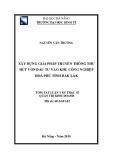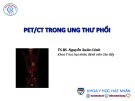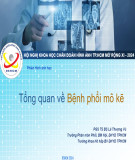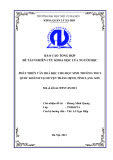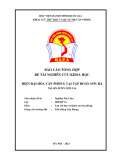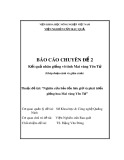
The effect of ST2 gene product on anchorage-independent growth
of a glioblastoma cell line, T98G
Yasushi Haga
1
, Ken Yanagisawa
2
, Hiromi Ohto-Ozaki
2
, Shin-ichi Tominaga
2
, Toshio Masuzawa
1
and Hiroyuki Iwahana
2
1
Department of Surgical Neurology and
2
Department of Biochemistry, Jichi Medical School, Minamikawachi-machi,
Kawachi-gun, Tochigi, Japan
The ST2 gene, which is specifically induced by growth sti-
mulation in fibroblasts, encodes interleukin-1 receptor-rela-
ted proteins and is widely expressed in hematopoietic, helper
T, and various cancer cells. However, the physiological as
well as pathological functions of the ST2 gene products are
not yet fully understood. In this study, we analyzed the
expression of the ST2 gene in human glioma cell lines and
human brain tumor samples with real-time polymerase
chain reaction method, the results of which revealed that the
expression level of the ST2 gene in glioma cell lines and
glioblastoma samples is significantly lower than that in a
fibroblastic cell line, TM12, and benign brain tumors, sug-
gesting the reverse relationship between malignancy and ST2
expression. As we could not detect the soluble ST2 protein
in the culture fluid of the T98G glioblastic cell line by
ELISA, we established stable transformants of T98G that
continuously produce and secrete the ST2 protein, in order
to study the effect of the ST2 protein on malignancy.
Although we could not detect a remarkable difference in
proliferation between transformants and control cells in
conventional tissue culture dishes, the efficiency of colony
formation in soft agar was significantly decreased in the
case of cells that continuously produce the ST2 protein.
Furthermore, inhibition of colony formation in soft agar
was observed in wild-type T98G cells when purified soluble
ST2 protein was added to the culture, in a dose-dependent
manner. Taken together, the results suggest that the
expression of ST2 suppressed the anchorage-independent
growth and malignancy.
Keywords: ST2; glioblastoma; anchorage-independent
growth; IL-1 receptor family; malignancy.
The ST2 gene, also known as T1, Fit-1, and DER4, was
originally found as a gene induced by growth stimulation
(hence the name ST2) in a murine fibroblastic cell line,
BALB/c-3T3 [1–6]. The subsequent structural analysis of
the ST2 protein, deduced from ST2 cDNA, revealed that it
was a soluble secreted protein very similar to the extracel-
lular portion of the interleukin (IL)-1 receptor [2]. To date,
we have identified at least three ST2 gene products,
generated by alternative splicing mechanisms. These prod-
ucts are ST2 (soluble secreted form), ST2L (transmembrane
receptor form), and ST2V (variant form of ST2) [2,7,8]. The
gene is also interesting in that it has two distinct noncoding
exon 1 regions and consequently two distinct promoters,
which are far apart from each other (for example, they are
25.4 kb apart in the case of human genes) [9]. Differential
usage of the two distinct promoters by cell type may be a
special means of regulation [10]. However, although the
structures of the ST2 gene products are very similar to that
of IL-1 receptor (IL-1R), these products never bind to
IL-1a,IL-1b, or receptor antagonist [11]. The ligands for the
receptor molecule are still unknown, thus leaving it as an
orphan receptor system.
A research breakthrough revealed that the ST2 gene
products were specifically expressed in type 2 helper T (Th2)
lymphocytes and not in Th1 cells [11–13]. The evidence of
suppression in eosinophilia by administrating anti-ST2 Ig or
modified soluble ST2 protein in asthma model mice [13] was
followed by discovery of the fact that the ST2 concentration
in serum of patients suffering from asthma attacks was
significantly higher than that in controls [14,15]. Elevated
serum ST2 was also detected in various autoimmune
diseases, such as systemic lupus erythematosus [16], suggest-
ing a significant relationship between ST2 and immunolo-
gical reactions. However, there is accumulating evidence that
the ST2 gene is expressed by various cancer cell lines, such as
those of hematological neoplasms [11,17,18], breast cancer
[19], and colon cancer (Tago, K. & Tominaga, S., unpub-
lished results). Furthermore, elevated ST2 protein concen-
tration in pleural effusions of lung cancer imply a
relationship between cancer and immunological responses
[20]. Therefore, the investigation of ST2 should be widely
based on both immunology and growth regulation.
Correspondence to S.-i. Tominaga, Department of Biochemistry,
Jichi Medical School, 3311-1 Yakushiji, Minamikawachi-machi,
Kawachi-gun, Tochigi 329-0498, Japan.
Fax: + 81 285 44 2158, Tel.: + 81 285 58 7323,
E-mail: shintomi@jichi.ac.jp
Abbreviations: IL, interleukin; MEM, minimum essential medium;
fetal bovine serum, fetal bovine serum; DMEM, Dulbecco’s modified
Eagle’s medium; GAPDH, glyceraldehyde-3-phosphate
dehydrogenase; ELISA, enzyme-linked immunosorbent assay;
HRP, horseradish peroxidase; FITC, fluorescein isothiocyanate;
TNF, tumor necrosis factor.
(Received 4 September 2002, revised 12 November 2002,
accepted 20 November 2002)
Eur. J. Biochem. 270, 163–170 (2003) FEBS 2003 doi:10.1046/j.1432-1033.2003.03377.x





